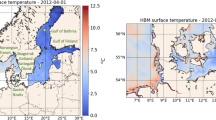Abstract
A coupled atmosphere-ocean model developed at the Institute for Space Studies at NASA Goddard Space Flight Center (Russell et al., 1995) was used to verify the validity of Haney-type surface thermal boundary condition, which linearly connects net downward surface heat fluxQ to air/sea temperature difference ΔT by a relaxation coefficientk. The model was initiated from the National Centers for Environmental Prediction (NCEP) atmospheric observations for 1 December 1977, and from the National Ocean Data Center (NODC) global climatological mean December temperature and salinity fields at 1°x 1° resolution. The time step is 7.5 minutes. We integrated the model for 450 days and obtained a complete model-generated global data set of daily mean downward net surface fluxQ, surface air temperatureT A, and sea surface temperatureT O. Then, we calculated the cross-correlation coefficients (CCC) betweenQ and ΔT. The ensemble mean CCC fields show (a) no correlation betweenQ and ΔT in the equatiorial regions, and (b) evident correlation (CCC≥0.7) betweenQ and ΔT in the middle and high latitudes. Additionally, we did the variance analysis and found that whenk=120 W m−2K−1, the two standard deviations, σQ and σκδT , are quite close in the middle and high latitudes. These results agree quite well with a previous research (Chu et al., 1998) on analyzing the NCEP re-analyzed surface data, except that a smaller value ofk (80 W m−2K−1) was found in the previous study.
Similar content being viewed by others
References
Blumberg, A., and G. Mellor, 1987: A description of a three dimensional coastal ocean circulation model. In:Three Dimensional Coastal Ocean Models (edited by N.S. Heaps), American Geophysical Union, Washington D. C., 1–16.
Budyko, M. I., 1956: Teplovoi balans zemnoi poverkhnosti, Gidrometeorologicheskoe izdatelstvo, Leningrad, 255 pp (US Weather Bureau translation: 'Heat balance at the earth surface', 1958, PB131692, 259 pp).
Cai, W. J., and Y. C. Chu, 1996: Ocean climate drift and interdecadal, oscillation due to a change in thermal damping.J. Climate,9, 2821–2833.
Chu, P. C., Y. C. Chen, and S. H. Lu, 1998: On Haney-type surface thermal boundary conditions for ocean circulation models.J. Phys. Oceanogr.,28, 890–901.
Greatbatch, R. J., G. Li, and S. Zhang, 1995: Hindcasting ocean climate variability using time-dependent surface data to drive a model: An idealized study.J. Phys. Oceanogr.,25, 2715–2725.
Han, Y. J., 1984: A numerical world ocean general circulation model. Part II: A baroclinic experiment.Dyn. Atmos. Oceans,8, 141–172.
Haney, R. L., 1971: Surface thermal boundary condition for ocean circulation models.J. Phys. Oceanogr.,1, 241–248.
Hansen, J., G. L. Russell, D. Rind, P. Stone, A. Lacis, S. Lebedef, R. Ruedy, and L. Travis, 1983: Efficient three-dimensional global models for climatic studies: Models I and II.Mon. Wea. Rev.,111, 609–662.
Kleeman, R., and S. B. Power, 1995: A simple atmospheric model of surface heat flux for use in ocean modeling studies.J. Phys. Oceanogr.,25, 92–105.
Marotzke, J., and P. Stone, 1995: Atmospheric transports, the thermohaline circulation, and flux adjustments in a simple coupled model.J. Phys. Oceanogr.,25, 1350–1364.
Oberhuber, J. M., 1988: An atlas based on the COADS data set: The budgets of heat, buoyancy and turbulent kinetic energy at the surface of the global ocean.Tech. Rep.,15, Max-Planck, Institut für Meteorologie, 199 pp.
Pierce, D., T. P. Barnett, and U. Mikolajewicz, 1995: Competing roles of heat and freshwater flux in forcing thermohaline oscillations.J. Phys. Oceanogr.,25, 2046–2064.
Rahmstorf, S., and J. Willebrand, 1995: The role of temperature feedback stabilizing the thermohaline circulation.J. Phys. Oceanogr.,25, 787–805.
Russell, G. L., J. R. Miller, and D. Rind, 1995: A coupled atmosphere-ocean model for transient climate change studies.Atmosphere-Ocean,33, 683–730.
Shapiro, R., 1970: Smoothing filtering and boundary effects.Rev. Geophys. Space Phys.,8, 359–387.
Weaver, A. J., and E. S. Sarachtk 1991: Evidence for decadal variability in an ocean general circulation model: An advective mechanism.Atmos.-Ocean,29, 197–231.
Xu, W., R. J. Greatbatch, and C. A. Lin 1995: The sensitivity of an eddy resoliving model to the surface thermal boundary conditions.J. Geophys. Res.,100, 15899–15914.
Author information
Authors and Affiliations
Rights and permissions
About this article
Cite this article
Chu, P.C., Yuchun, C. & Shihua, L. Evaluation of Haney-type surface thermal boundary conditions using a coupled atmosphere and ocean model. Adv. Atmos. Sci. 18, 355–375 (2001). https://doi.org/10.1007/BF02919315
Received:
Revised:
Issue Date:
DOI: https://doi.org/10.1007/BF02919315




